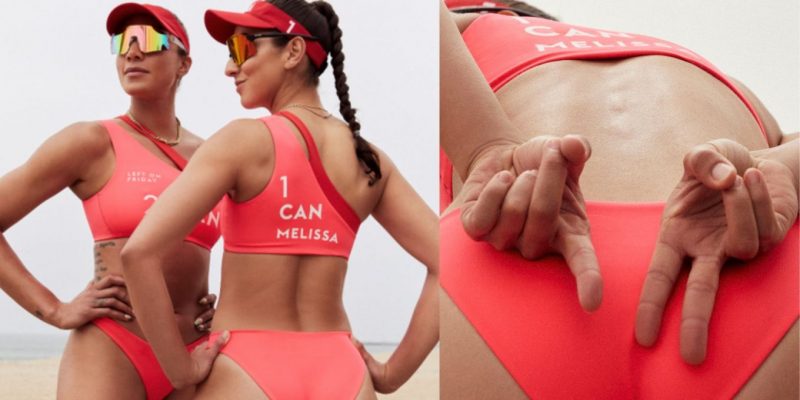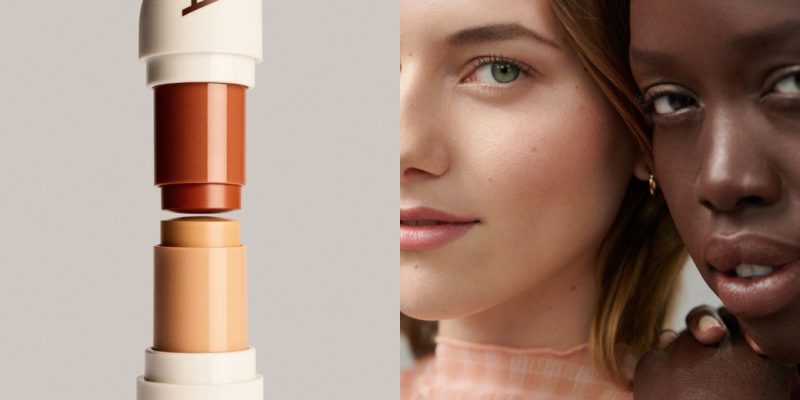Makeup & nails
TikTok Made Beauty Content Fun Again
Eschewing beauty-vlogger drama on YouTube and Instagram’s overly curated aesthetic, gen Z has turned to TikTok for a tongue-in-cheek take on beauty – and brands are following.
by : Souzan Michael Galway- Feb 24th, 2020

Salini Perera
Last April, hair-care brand Marc Anthony noticed a mysterious uptick in the sales of its hero collection, Strictly Curls – a line that launched in 1997. After doing some digging, the brand found that the spike was due to the #StrictlyCurls challenge, in which users applied the products to wet hair and showed off the results, on three-year-old video app TikTok. Today, the hashtag has over 9.5 million views, contributing to the 60 percent increase in product sales. Similarly, in October, Clairol Professional saw its Shimmer Lights Shampoo, which launched in the ’80s, go viral on TikTok thanks to the #PurpleShampooChallenge (it currently has 11.5 million views), which involved users coating their heads in an entire bottle of the product.
At the beginning of 2019, TikTok was the third most downloaded app globally, with more than half a billion users around the world. Forty-one percent of the app’s users are between the ages of 16 and 24, which makes the success of the aforementioned Marc Anthony and Clairol Professional products even more curious—not only did they launch decades ago but the former brand’s demographic is usually women between the ages of 25 and 40 and the latter product was originally launched to brighten greying hair.
TikTok is meme-driven, says Mae Karwowski, founder and CEO of Obviously, a New York-based influencer tech marketing company. Users’ tongue- in-cheek fascination with “old-school” beauty products demonstrates that to be successful on the platform is to constantly be in on the joke. It’s not that teens hadn’t heard of these drugstore products prior to last year’s TikTok challenges – they’re simply finding new and entertaining ways to showcase familiar items, whether it be via unconventional uses or by pairing how-to tutorials with music and special effects.
“For gen Z – the generation who has already watched enough YouTube videos to know how to contour and who grew up learning how to decipher the ingredient label on any skincare product – the ability to be an active participant in a conversation, after years of being a viewer, is massively appealing.”
Once a challenge takes off, users will respond to it by turning the meme “45 degrees and making it [their] own,” says Karwowski. “You’ll see the repetition of the same product giving one post so much more life.” For gen Z – the generation who has already watched enough YouTube videos to know how to contour and who grew up learning how to decipher the ingredient label on any skincare product – the ability to be an active participant in a conversation, after years of being a viewer, is massively appealing.
TikTok’s success when it comes to beauty videos relies largely on its no-frills attitude. It’s not the place for “a fully orchestrated makeup tutorial,” says Alecsandra Hancas, a director at market-research firm NPD Group. As the popularity of VSCO girls (an online subculture that’s named after the photo-editing app and largely made up of teen girls with a penchant for oversized hoodies, Birkenstocks and a face free of makeup – other than a swipe of Glossier lip balm) demonstrated last year, gen Z is taking a skincare-first approach to beauty, and the shift has been reflected in sales. A couple of years ago, categories like foundation, glitter makeup and eyeshadow palettes reigned supreme, but that’s no longer the case. “Skincare is on track to reach about a billion dollars in Canada,” says Hancas, making it the first global market to see higher sales in skincare than makeup. These days, she says, “makeup is almost a secondary thought.”
“The pressure is off to create something filtered, FaceTuned and aesthetically 'flawless.'”
Makeup tutorials do still exist on TikTok (the more experimental ones are courtesy of e-girls and e-boys donning Euphoria-esque makeup), but they each clock in at a refreshing – yet addictive – 15 to 60 seconds long. And unlike traditional tutorials, they don’t have to be “as aspirational or inspirational as posts on Instagram,” says Hancas. Instead of an elaborate set-up, TikTok videos are usually filmed in the most unglamorous of places: a messy bedroom or a (ring-light-free, dimly lit) bathroom. TikTok’s low-stakes, high-rewards model has resonated with gen Z. The pressure is off to create something filtered, FaceTuned and aesthetically “flawless” – a look that was perfected by millennials but is being rejected by gen Z. This may be a much-needed relief for teens, considering that studies have found that Instagram is the social-media platform that’s most damaging to mental health. Since TikTok videos are so short and easy to consume, they spread rapidly once they go viral.

“The bar is pretty high on Instagram right now in terms of aesthetics,” says Karwowski, whose company worked with Millie Bobby Brown’s new beauty brand, Florence by Mills, on a TikTok campaign when it launched in Ulta Beauty. The brand opted for in-store shade-swatching videos instead of the high production value and bells and whistles that consumers have come to expect, making the videos feel more authentic. On TikTok, thoughtfully-planned-out grids and gorgeous backdrops need not apply. Even larger brands, like Fenty Beauty, are using the platform to take viewers behind the scenes, posting videos of staff holiday parties and meetings in between short, easy-to-consume makeup tutorials.
Needless to say, there are no weeks-long teasers leading up to an underwhelming product launch or brand collab on TikTok, nor are there hard-to-follow, back-and- forth accusation videos. The drama-free platform was also ad-free until last year, when it started testing them, allowing brands to merely dip a toe into the app’s potential for monetization dollars.
TikTok influencers are largely teens who grew up consuming – but not creating – content on YouTube and Instagram, says Karwowski. The majority of the influencers she works with found online popularity on TikTok as opposed to migrating from one of the more established platforms. “Some haven’t even worked with brands yet, but they have a million followers,” she says. When it comes to creating sponsored content on TikTok, something that brands and influencers have only recently begun to explore, Karwowski explains that brands have to hand over more creative control to content creators than they might be used to in order to maintain the platform’s unique sense of humour and spontaneity. Whether TikTok allows for more experimentation simply because the platform is relatively new or because its approach to beauty is a rejection of the perfect aesthetics of YouTube and Instagram beauty remains to be seen. But for the time being, says Karwowski, “none of those [aesthetic] standards apply.”
This article originally appeared in the March 2020 issue of ELLE Canada. Subscribe here.
READ MORE:
How To Keep Black Hair Healthy While Working Out
Newsletter
Join our mailing list for the latest and biggest in fashion trends, beauty, culture and celebrity.
Read Next

Fashion
This Canadian Swimwear Brand Designed Canada’s 2024 Women’s Olympic Beach Volleyball Team Uniforms
And they're *so* good.
by : Allie Turner- Apr 24th, 2024
Fashion
The Most Iconic Looks In Met Gala History, From 1973 To Now
40 years of the night that's all about trailblazing fashion.
by : ELLE Australia- Apr 24th, 2024

Beauty
Tested and Approved: A Skin Saviour That Works While You Sleep
Wake up with your glowiest skin yet—even if you didn’t clock eight hours.
by : ELLE Canada- Apr 11th, 2024




